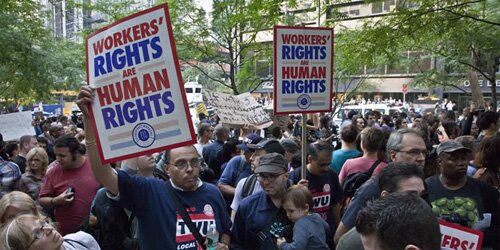Recent Articles
What happens now to Guantánamo?
Back in March, I published a four-part list identifying all 779 prisoners held at Guantánamo since the prison opened on January 11, 2002, as “the culmination of a three-year project to record the stories of all the prisoners held at the US prison in Guantánamo Bay, Cuba.” Now updated (as my ongoing project nears its four-year mark), the four parts of the list are available here: Part One, Part Two, Part Three and Part Four.
The first fruit of my research was my book The Guantánamo Files, in which, based on an exhaustive analysis of 8,000 pages of documents released by the Pentagon (plus other sources), I related the story of Guantánamo, established a chronology explaining where and when the prisoners were seized, told the stories of around 450 of these men (and boys), and provided a context for the circumstances in which the remainder of the prisoners were captured.
I’ve also been tracking the Obama administration’s stumbling progress towards closing the prison, reporting the stories of the 41 prisoners released since March, and covering other aspects of the Guantánamo story.
Overall, as it stood at December 31, 2009, 574 prisoners had been released from Guantánamo (42 under Obama), one — Ahmed Khalfan Ghailani — had been transferred to the US mainland to face a federal court trial, six had died, and 198 remained.
continue reading… »
Torture cannot be hidden forever
Thursday’s extraordinary announcement that the Attorney General, Baroness Scotland, has been asked by Home Secretary Jacqui Smith to investigate possible “criminal wrongdoing” by MI5 and the CIA in the case of Binyam Mohamed, a British resident held in Guantánamo Bay, Cuba, is the latest, and perhaps most significant example of the use of torture coming back to haunt the torturers.
Mr. Mohamed’s lawyers have spent over three years attempting to secure information proving that their client, seized in Pakistan in April 2002, was rendered by the CIA to 18 months of torture in Morocco, and was then transferred to a CIA prison in Afghanistan, before arriving in Guantánamo in September 2004.
Diego Garcia: no return to “torture island”
In the end, then, it was no surprise that the exiled Chagos Islanders’ right to return to their former homes was turned down by the Law Lords in London.
In the 1960s, Diego Garcia, the centerpiece of the Chagos Islands (which are part of the British Overseas Territories) was leased to the United States for use as a strategically important airbase.
The deal had two crucial components: one was a sizeable discount on Trident Polaris, Britain’s nuclear missile programme, and the other was the removal from the islands (to a life of poverty in Mauritius and the Seychelles) of the 2,000 inconvenient British subjects (the “residents”), who traced their ancestry back nearly 200 years to African- and Indian-born labourers from Mauritius, shipped in by French coconut planters in the years before Napoleon’s fall and the transfer of the islands’ sovereignty to the UK.
US election: Obama and McCain shirk discussion of Guantánamo and executive overreach
While pundits have been busy analyzing Friday’s Presidential debate, no one has been talking about a crucial issue that has disappeared from the election campaign since Barack Obama won the Democratic nomination in August, even though it is absolutely central to the complaints about the Bush administration’s behaviour over the last seven years.
The issue is unfettered executive power, and it has been manifested, to the horror of the world, and the dismay of Americans who pride themselves on being a nation founded on the rule of law, in the endorsement of torture as official US policy, the transformation of the CIA into an organization that has run a colossal “extraordinary rendition programme” and a network of secret prisons around the world, and the detention of thousands of prisoners without charge or trial in a legal black hole between the Geneva Conventions and the US court system.
In Guantánamo, Afghanistan and Iraq, over 20,000 prisoners in US custody are held neither as Prisoners of War, who would be protected from “humiliating and degrading treatment” and coercive interrogations by the Geneva Conventions, nor as criminal suspects who will be tried in a US court. The only trials put forward by the government — the Military Commissions at Guantánamo — are so tainted by accusations of pro-prosecution bias and the suppression of exculpatory evidence that the administration is fighting a losing battle to establish their legitimacy, nearly seven years after they were set up by Dick Cheney and David Addington. continue reading… »
The journey from Guantánamo
Last weekend, Clive Stafford Smith, the Director of the legal action charity Reprieve, travelled to Sudan to meet the recently released al-Jazeera cameraman Sami al-Haj. He had been represented by Reprieve since 2005 and was now a free man. This is an edited version of Clive’s report, which includes a passage specifically refuting Pentagon claims that Mr al-Haj, who had been on a hunger strike for 16 months prior to his release, and was taken to a hospital on his arrival in Sudan, “seemed like a healthy individual” as he departed from Guantánamo.
continue reading… »
Guantánamo Files: stories from America’s illegal prison
(Book launch info at the end)
We are just seven weeks away from a particularly disturbing anniversary. On January 11, 2008, the Bush administration’s notorious “War on Terror” prison at Guantánamo Bay will have been open for six years. For all this time, the prisoners – or “detainees,” as the government insists on describing them – have been held without charge or trial, and with no sign of when, if ever, they will be released from what Lord Steyn, the British law lord, memorably described as a “legal black hole.”
Although 464 of these men have now been released – or, in rather fewer cases, transferred to the custody of their home governments – their stories remain largely unknown, as do those of the majority of the 310 detainees still held at Guantánamo.
In February 2006, when I first began researching the detainees’ stories, it was this combination of factors – the exceptional flight from domestic and international law on the part of US administration, and the fact that almost nothing was known about the men imprisoned in Guantánamo – that first prompted me to action.
In the first weeks of my research I was restricted, like everyone else who had attempted to answer the question, “Who is in Guantánamo?” to news reports and interviews with released detainees, and trawls for information that were often based on little more than gossip and rumour.
continue reading… »
NEWS ARTICLES ARCHIVE


















